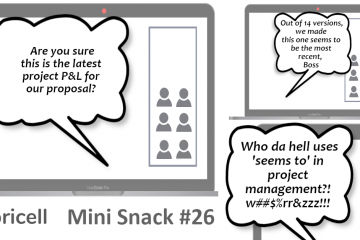
Is It Easy?
No, It is not easy at all.
We all know projects can face challenges in multiple areas: customer satisfaction, scope management, change management, etc. Most of whose challenges if not addressed, sooner or later will result in financial issues.
Here are some examples of situations which can make easier or harder to recover project financially if that happens.
Do We Have Issues?
But before …. How do we know we have a financial issue with the exception of general feeling something is wrong? Here are a few ways to make it checked it in real.
First when it gets visible on actual project data. Most spectacular is when actual spending is already higher than the planned cost. Very often this is coming from the tracking system automatically so, project managers cannot manage publicity here. This is the worst case. We probably are at the end of the project and there is almost nothing you can do except try to minimize issues, quickly deliver and close projects with tight financial management. But realistically in my experience 99% you close that project with cost overruns. Bad news for those who don’t manage the project financially – if the project has issued those symptoms will come anyway.
Much different situation is when a project is properly tracked financially, and we can see the Actual Cost got close and higher than Earned Value, as we run the project. This signal is happening much earlier than in the previous case. This is a much better situation as it proves the project manager is managing the project financially. However, some found EVA is not super easy to use in sense it is not always easy to define and monitor Earned Value itself. Very much depends on the project.
Some prefer to indicate we have financial issues by comparing Estimate at Completion (EAC) with a planned budget. Many found this much easier to define and monitor. And it works for any projects, no need to define Earned Value (please mind we don’t intend to demote EVA methodology here).
Actual or Prediction (Sunk Cost vs ETC)
Ok, so what is the deal with project financial recovery? The chances if we can recover or not, depends on very much if the financial issue is in Actual or Prediction.
The other words can be used: Has an issue happened already - as part of Actual Cost or Sunk Cost or it is planned to happen in the future – as Estimate to Completion Cost.
Sunk Cost – this is when the additional cost has been spent already. It is very much what EVA analysis will confirm. But solid EAC calculations will the job as well. Typical examples are longer “Requirements Analysis Phase”, or more project “Kick off/ Rump Up” time. At the beginning of the next phase that costs is sunk already.
ETC – Estimate to Complete is all that is ahead of the project. If he can see that project in the future will take more cost than planned, there are many more chances he can recover. Typical cases are a person who will leave the project and there is a need to replace him with a higher cost rate resource, or longer Product Testing Phase planned.
What Are Real Chances to Recover?
Recovering Sunk Cost is very hard. The project already consumed more cost than planned and it took money from other parts already. Delivering on cost would mean delivering other parts at less cost than planned. It will most likely compromise the quality of other parts of the project or simply be impossible. There may be some chances to make more synergies and recover. Will very much depend on the budget left and stage of the project.
Recovering ETC has more chances. You still can make decisions as cost is not sunk yet. It does not mean it is easy or possible. But naturally You have more space to maneuver.
In both cases the very handy tool always is - risk budget. If cost overruns are not dramatically high (we are not talking complete project financial disaster) this is where risk budget comes with help.
"Recovering ETC has more chances over Sunk Cost. You still can make decisions as cost overrun has not happened yet"
If the Risk Budget cannot cover fully the cost overrun, the best recovery strategy is at least to make sure the root cause of additional cost is not affecting more and stabilize the project till the end of delivery. And obviously manage financials very, very tight till the end.
In practice many times this is only possible approach and exactly what is meant as project recovery.
Conclusions
It is very hard to recover financially in all cases, but especially Sunk Cost.
There are our 4 points to make sure you can easier address potential financial challenges:
- Make sure you have a solid baseline for cost at a start, so you can measure project financial performance.
- Make sure you always have a risk budget planned – it does not matter the type of project you have.
- Regularly, meaning very regular, validate Earned Value or EAC/ETC information.
- Take actions based on what you see from the previous point.
All of the above requires discipline and tools. There are many tools available today to help execute the project financially.
To make it “short essential” - financial discipline from project start is everything.



